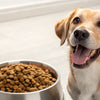Why Won’t My Dog Eat Kibble? Understanding Your Pup's Eating Habits
- Houndsy
Table of Contents
- Introduction
- Medical Reasons for Not Eating Kibble
- Behavioral Reasons for Not Eating Kibble
- The Impact of Treats on Eating Habits
- Quality of Kibble Matters
- Solutions to Get Your Dog Eating Again
- When to Seek Veterinary Help
- Conclusion
Introduction
As dog lovers, we often find ourselves puzzled when our furry companions suddenly turn up their noses at their favorite kibble. Did you know that approximately 20% of dogs experience a change in their eating habits at some point in their lives? That's a significant number, making it a common concern among pet parents. The reasons behind this behavior can range from medical issues to simple pickiness, and understanding why our dogs refuse their kibble is essential for their health and well-being.
In this blog post, we will delve into the various factors that might lead your dog to refuse kibble, exploring medical, behavioral, and dietary influences. By the end of this article, you will have a comprehensive understanding of the potential reasons behind your dog’s picky eating habits and actionable solutions to encourage them to eat their kibble again.
Join us as we explore why your dog may not be eating kibble and discover how we can enhance their feeding experience, making it more enjoyable and healthier.
Medical Reasons for Not Eating Kibble
Dental Issues
One of the most common medical reasons for a dog's refusal to eat kibble is dental problems. Just like humans, dogs can suffer from tooth decay, gum disease, and other dental issues that make chewing painful. If your dog is hesitant to eat dry kibble but shows interest in softer foods, it may be time for a dental check-up. Regular veterinary visits can help catch dental issues early, ensuring your dog remains comfortable during mealtime.
Gastrointestinal Problems
Another critical factor to consider is gastrointestinal discomfort. Dogs can experience stomach upsets due to various reasons, including dietary indiscretions, infections, or underlying health conditions. If your dog seems lethargic and avoids kibble, they may be experiencing nausea or other digestive issues. In such cases, a veterinarian's evaluation is essential to rule out serious health concerns and to determine if a temporary bland diet (like boiled chicken and rice) is necessary.
Age-Related Changes
As dogs age, their dietary needs and preferences can change significantly. Senior dogs may develop conditions like arthritis, which can make eating from a standard food bowl uncomfortable. Additionally, their senses, particularly smell and taste, may diminish, leading to a decline in appetite. If your dog is older and refusing kibble, consider transitioning to softer food options or elevating their bowl for easier access.
Serious Health Conditions
In more severe cases, a sudden loss of appetite can signal a serious health issue, such as liver disease, kidney problems, or even cancer. If your dog exhibits persistent refusal to eat kibble combined with other symptoms like vomiting, diarrhea, or significant weight loss, it is crucial to seek veterinary assistance immediately. Early intervention can make a significant difference in treatment outcomes.
Behavioral Reasons for Not Eating Kibble
Stress and Anxiety
Dogs are sensitive creatures, and changes in their environment can lead to anxiety and stress that affect their eating habits. Factors such as moving to a new home, the introduction of new pets, or loud noises can disrupt their routine and make them unwilling to eat. Creating a calm feeding environment and maintaining a consistent routine can help alleviate anxiety and encourage your dog to return to their kibble.
Picky Eating Habits
Sometimes, dogs develop picky eating habits based on learned behaviors. If your dog has been spoiled with table scraps or treats, they may refuse their kibble in favor of more enticing options. To counteract this, we recommend sticking to a strict feeding schedule and avoiding giving in to their demands for human food. Consistency will help them understand that their meal options are limited to what is provided in their bowl.
Boredom with Food
Like humans, dogs can get bored with their meals. If your dog has been eating the same kibble for an extended period, they may lose interest. To combat kibble fatigue, consider rotating flavors or brands, or adding healthy toppings to make their meals more appealing. Mixing in wet food or using a kibble dispenser that offers variety can keep mealtimes exciting.
The Impact of Treats on Eating Habits
While treats are a great way to reward our pets, excessive snacking can lead to a decrease in interest in their regular kibble. Treats should only make up about 10% of a dog's daily caloric intake. If your dog seems uninterested in their kibble, evaluate their treat intake and adjust accordingly. Reducing treats can help stimulate their appetite for their regular meals.
Quality of Kibble Matters
Not all kibble is created equal. Low-quality dog food with fillers, artificial preservatives, or unappealing flavors can lead to a decline in your dog’s interest in eating. If you've recently switched brands or types of kibble, it may be worth investigating the quality of the ingredients. Opting for high-quality kibble made with real meat and wholesome ingredients can make a significant difference in your dog's eating habits.
Solutions to Get Your Dog Eating Again
Enhance the Meal Experience
To encourage your dog to eat their kibble again, consider enhancing the meal experience. Here are some tips:
- Mix in Wet Food: Combining kibble with wet food can make it more appealing. The added moisture can enhance the aroma and flavor, enticing your dog to dig in.
- Use Tasty Toppers: Adding healthy toppers like canned pumpkin, plain yogurt, or even a bit of bone broth can stimulate interest in their kibble.
- Switch Up the Bowl: Believe it or not, the bowl your dog eats from can affect their appetite. Experimenting with different types of bowls, such as elevated or stainless steel options, may encourage them to eat.
Establish a Feeding Schedule
Creating a consistent feeding schedule can help regulate your dog’s appetite. Offering meals at the same time every day and removing any uneaten food after 15-20 minutes encourages your dog to eat when food is available. This method can help reinforce the importance of mealtime and reduce grazing habits.
Monitor Hydration
Sometimes, dogs refuse kibble due to dehydration. Ensuring your dog has access to fresh water at all times can encourage them to eat. You can also try adding water or low-sodium broth to their kibble to make it more appealing.
Gradual Food Transition
If you need to switch your dog’s kibble to a new brand, do so gradually. Mix the new kibble with the old one over several days to allow your dog to adjust to the new flavor and texture. A sudden change can lead to gastrointestinal upset or further refusal to eat.
When to Seek Veterinary Help
While many cases of kibble refusal can be resolved with behavioral adjustments, it’s vital to consult your veterinarian if your dog's refusal to eat persists for more than 24 hours, especially if accompanied by other concerning symptoms. Early intervention can help identify any underlying health issues and ensure your dog's well-being.
Conclusion
Understanding why our dogs may refuse to eat kibble can enhance not only their health but also the quality of our relationship with them as pet parents. By recognizing the medical, behavioral, and dietary factors that influence their eating habits, we can take proactive steps to encourage healthy eating.
Remember, at Houndsy, we believe that feeding time should be a joyful and stress-free experience for both dogs and their owners. Our flagship product, the Houndsy Kibble Dispenser, is designed to make mealtime easier and more enjoyable, featuring perfect portion control, stylish design, and ergonomic convenience.
By enhancing your dog's feeding experience, you can help them rediscover their love for kibble while also creating a beautiful mealtime ritual that you both enjoy. So, if you’re looking for a way to elevate your dog’s feeding routine, explore our Houndsy Kibble Dispenser and see the difference it makes!
FAQ
Q: What should I do if my dog refuses to eat kibble for more than a day?
A: If your dog refuses to eat kibble for more than 24 hours, especially if they show other symptoms like vomiting or lethargy, it's crucial to consult a veterinarian. They can help identify any underlying health issues.
Q: Can I mix wet food with kibble?
A: Yes! Mixing wet food with kibble can enhance its flavor and moisture content, making it more appealing to your dog.
Q: How can I tell if my dog's food is bad?
A: Check for an expiration date and examine the kibble for any unusual smells or textures. If it smells sour or feels tacky, it may be spoiled.
Q: Should I force-feed my dog if they won’t eat?
A: No, you should not force-feed your dog. Instead, try to encourage them with more enticing options and consult your vet if the issue persists.
Q: How can I make my dog's kibble more appealing?
A: Consider adding healthy toppers like pumpkin, yogurt, or low-sodium broth, and vary their feeding routine to maintain interest in their meals.












